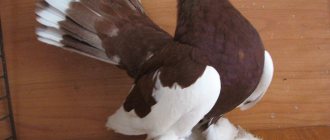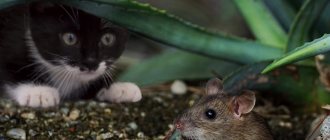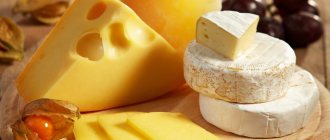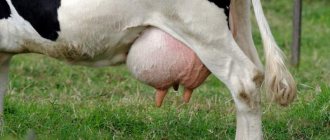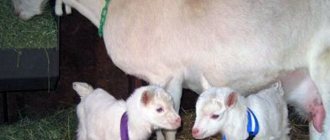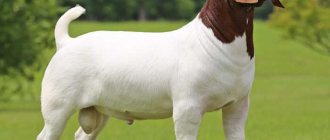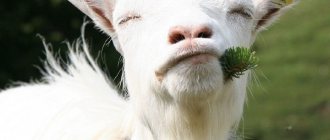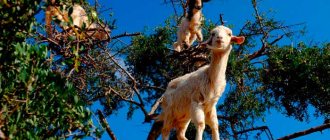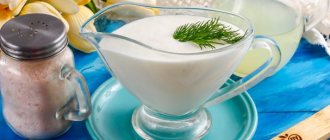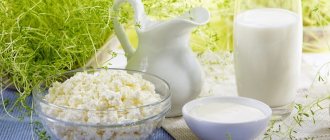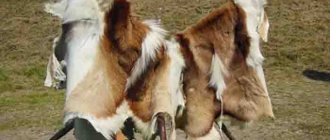How to choose a good milking goat (kid) when purchasing.
General rules. First of all, do not rush to buy a goat at the market.
It is better to visit the farm of those who offer young animals, carefully examine the mothers in labor, the sire fathers from whom the offspring were born, inquire about the milk yield of the goats, and see how they are kept.
It should be taken into account that the offspring of purebred goats with high milk productivity are expensive.
But, as experience confirms, it is better to overpay than to buy a bad animal. It has long been noted: 2 purebred goats will replace 4, or even 5 non-pedigreed ones.
Under no circumstances should you purchase young animals from inbreeding. Such mating leads to the reduction of the breed, decreased productivity, disruption of vital functions, and increases the likelihood of deformities, diseases and even death of adult goats during childbirth. Unfortunately, many goat breeders, unaware of the harmful consequences this leads to, leave newborn goats and keep them until they give birth to their parents, sisters, and nieces.
It would be good to clearly understand before purchasing why the goat is being purchased. If you need healing goat milk for a weakened child or a sick person and you are ready to keep an adult animal, then it is better to buy a dairy goat. However, we must take into account that it is quite difficult to purchase an adult animal without any flaws, especially in the spring and summer. Owners are reluctant to part with their pets, even if they are old. A good kid is easier to find.
But if you do buy an adult goat, you need to pay attention to its appearance, behavior, and reaction to others. A healthy goat has smooth, shiny hair, bright, cheerful eyes, a clean nose, and silent breathing. The legs and back are straight, without obvious deflections, the udder is pear-shaped, elastic, the nipples are medium, comfortable for milking. But a sick or elderly animal is most often depressed, its fur is ragged, dull, and its belly is saggy.
It would be nice to take a cracker with you and treat the goat. If she is healthy, the cracker will be eaten instantly. An old or sick goat will roll it in its mouth from side to side until the cracker gets soggy, and only then will it swallow.
It is best to choose a large goat: it is stronger, its productivity is higher than that of small goats. It has been noticed that a goat that produces good, tasty milk does not have an unpleasant odor in the frontal part of the head, between the horns. To determine the smell, you need to scratch it in this place and smell your hands. Ask your hosts to taste cold milk to find out its taste. And most importantly, you should definitely try to milk a goat yourself.
When buying a kid, you should follow the same rules as when choosing an adult animal. Ask what the baby was fed, how many times a day, at what hours and in what quantity food was given. After installing a kid, you should try not to change its diet, at least at first.
We must also remember that goats do not like loneliness, so it is better to purchase 2 young goats at once. They themselves will not be bored, and they will amuse their owners.
If you decide to purchase a goat or kid of the Saanen breed, you need to pay attention to the fact that these animals have smooth, very short hair, and there is no undercoat or goat down underneath it, like goats of other breeds. Goats of this breed are slender, with a high neck, and most are polled and hornless.
Practice has shown that domestic mixed-breed goats, born from crossing with Saanen sires, are almost as good as purebred foreign specimens. They are more hardy, unpretentious in food, tolerate cold well, get sick less often, and in terms of milk production they practically reach the level of Saanen goats. Crossbred old goats can consistently produce 6.5 liters of excellent milk in the summer; their daughters, after the second lambing, can produce 4.5 liters.
The average productive life of animals is 10-12 years. Under good feeding and maintenance conditions, they continue lactation until 15-18 years of age. Goats reach their highest milk production at 6-7 years of age.
Depending on the direction of productivity, animals have specific characteristics, which you should first pay attention to when choosing goats for breeding on the farm.
Varieties of goats, their characteristics and comparison
Before you go shopping for an individual, you need to thoroughly study the characteristics of the color. After all, without experience, you get a pig in a poke. An unscrupulous seller will immediately see a confused buyer in the crowd and sell the most substandard goods. To avoid such a situation, a complete description of the different species and their characteristics is offered, which makes it easier to solve the question: how to choose a goat when buying anywhere.
1. Representatives of dairy breeds
Russian
One of the most popular colors, the appearance is known to everyone. These goats have Swiss blood in their veins. In the northern part of the country it is difficult to keep such an individual, since it does not tolerate blowing air and is susceptible to frequent mastitis.
The appearance differs as follows:
- height about 69 centimeters;
- the head is not voluminous;
- colors: gray, red, spotted, white, black;
- the body is like a barrel;
- legs are thin, high;
- the presence of a beard and horns in both sexes;
- weight on average up to 50 kilograms.
This breed is quite productive, the annual milk yield is up to 1000 liters of milk with a fat content of 4-5%. For one milk yield, the Russian yields up to half a liter. We will show you how to choose a dairy goat.
At 8 months, a representative of this species is ready to mate. But it is advisable to wait a few more months to gain more weight. It is recommended to happen no more than twice a year. The offspring is 2-3 cubs.
Distributed throughout Russia, Belarus, and Ukraine.
Cameroonian
Profitable due to high milk yield. On average, per day it can produce up to 2 liters of milk with a fat content of 4.5-5.5%. It is tasty and can be stored for a long time (in a cold place for up to two weeks).
Representatives with West African roots arrived in Russia several decades ago. It has a dwarf height, no more than half a meter. Food consumption is low. Description:
- length no more than 70 centimeters;
- the presence of horns curved back;
- tail and ears erect;
- the female weighs up to 15 kilograms, and the male – no more than 23;
- variety of suits.
Offspring – 2-4 units.
The Cameroon breed does not tolerate loneliness and is difficult to milk due to its short stature.
Toggenburg
About two hundred years ago it was developed in Switzerland. Description:
- light brown color;
- ears, legs – white;
- height does not exceed 80 centimeters;
- the body is elongated and thin;
- no horns;
- the neck is long and thin;
- the udder is large, voluminous;
- The weight of the female is 55 kilograms, the male is 90.
They differ in the litter of two or three cubs. It is difficult to answer the question of what breed of goats to choose in the end. The milk yield of representatives of this color is one of the most significant - up to 1.2 tons per year. At one time you can milk from 400 grams to a liter of milk with a fat content of 3-4%. Cheeses are often made from it. Milk tastes good when you eat well. If the food is of poor quality, the drink will taste and smell unpleasant. Milking her is comfortable due to her height.
It has a calm character and resistance to cold. Distributed in St. Petersburg and its outskirts, Altai.
Gorkovskaya
Brought out at the beginning of the 20th century. Shows good milk production. Normal appearance:
- colors white, gray;
- the body is of medium size, quite strong;
- high no more than 62 centimeters;
- presence of horns in both sexes;
- small udder;
- hooves of the correct shape;
- The weight of a female is up to 45 kilograms, a male is up to 80.
The offspring is usually no more than two kids. Although there were cases of five births. Milk yield is high - 1.2 tons per year. Milk fat content is 4-5.5%. You can milk about half a liter at a time. With a balanced diet, milk yield increases significantly.
The breed is distinguished not only by its dairy products, but also by the quality of its meat and skin. Distributed throughout Russian territory. Representatives are unpretentious in terms of care and food quality. Adapt to any temperature fluctuations. The female gives a normal amount of milk only after her second birth.
Saanen Dairy
Brought out in Switzerland about five hundred years ago.
Description:
- white color;
- the body is massive;
- height about 90 centimeters;
- hornless;
- the neck is long;
- udder is voluminous;
- The female weighs 60-80 kilograms, the male – 110.
The offspring is 2-3 pieces. The annual milk yield is 900-1200 liters of milk with a fat content of 4.5%. There is no unpleasant odor. For normal performance, the feed must be of high quality. Does not tolerate bad weather conditions well and often gets sick. A purebred female is quite expensive and rare. Above are the most productive dairy goats.
Alpine
Homeland: Switzerland. Description:
- different colors;
- height 75-85 centimeters;
- the body is lighter than the ears, legs, head;
- the head is small;
- often hornless;
- ears are straight;
- The weight of females reaches 63 kilograms, males - 79.
The breed is very old. Offspring - up to three units. Milk yield is average - up to a ton per year. Although with good nutrition it can reach one and a half tons. The fat content of milk is 4-5.5%. The drink has no foreign odor and a delicate taste. It is often used to make cheese.
Distributed in the Caucasus and the south of the country. Animals have endurance and resistance to weather conditions. They can be aggressive towards members of their own breed.
Downy breeds
Orenburgskaya
The coat is one color, most often black. Rarely found white, reddish. Quality depends on age (the darker, the stronger). Productivity of wool and down up to 400 grams. From a seven-year-old individual, the down is cut brittle. There is no elasticity.
The offspring is 2-3 kids. Milk yield does not exceed 100 liters per year. The weight of the female is up to 46 kilograms, and the male is 72.
This breed is resistant to cold weather.
Pridonskaya
Popular near the Don. It has a strong massive body, backward-curved horns, and wavy fur. The weight of the female is 38 kilograms, the male’s weight is up to 67.
Milk yield is small, about 130 liters. Down production is very high and depends on gender. Females give from 380-1350 grams, and males - 450-1500 grams. The highest rate is from 4 to 6 years. The color of the down is white or gray. It is quite elastic. Winter scarves are knitted from this material, and shoes and winter outerwear are made from the skin.
Gorno-Altai
The body is massive, barrel-shaped. The horns are curved back. The ears are erect.
Tolerates cold weather well and is not afraid of frost. The female weighs about 40 kilograms, and the male – 60. The offspring is 2-3 pieces.
Down production is quite large, about 500 grams per animal. It is soft and strong. Milk yield is small, about 450 g per day. During the lactation period, no more than 100 liters of milk are produced.
Meat breeds
Burskaya
The physique is strong, the muscles are developed. The female weighs 90-100 kilograms, and the male – 135. The coat is white or with the addition of a red color. The horns are large, dense, and grow to the sides. The offspring is about three kids. The character is calm. Unpretentious to climatic conditions.
The meat is tender and does not taste like veal. Applicable to dietary nutrition.
Kiko
The body is dense, the head is small, with curled horns and hanging ears. Males have a beard. The weight of the female is about 50 kilograms, and the male is 70-90. The offspring is 2-3 kids.
Males are quite aggressive. The breed is unpretentious to food and weather conditions. Not afraid of cold, has excellent immunity.
Greek
Color: white, red, brown. The body is large with a long neck. The horns are curved back or to the sides. Legs are tall and thin. The female’s weight is about 50 kilograms, and the male’s is 60. Milk yield is small, only 100 liters per year. The milk has a pleasant, fatty taste. Cheeses are made from it. The meat is tasty, tender, without foreign odors. Pink colour. She is calm in character and not picky about food.
Now the secret of how to choose a goat has been revealed.
Milk production (comparison):
| Breed | Liters of milk per year |
| Russian | 500-1000 |
| Cameroonian | 600-1200 |
| Toggenburg | 400-1200 |
| Gorkovskaya | 1000-1200 |
| Saanen Dairy | 900-1200 |
| Alpine | 800-1000 |
| Orenburgskaya | 100 |
| Pridonskaya | 130 |
| Gorno-Altai | 100 |
| Burskaya | 100 |
| Kiko | 100 |
| Greek | 100 |
Content Features
Most dairy goats are easy to care for, but all of them do not tolerate dampness and drafts, and do not like severe frosts. Pay attention to this point when arranging the barn.
Valuable recommendations for arranging a barn:
- Insulate the floor, otherwise the animal will get sick.
- Close all cracks to prevent rodents from entering.
- Regularly disinfect the room from harmful insects
- Maintain cleanliness and order in the barn.
- Control the air temperature, the optimal range is 3-5 degrees.
- Provide each goat with an individual waterer and feeder.
Features of nutrition and care:
- Renew water in drinking bowls 2 times a day, more often in summer. Expect that 1 goat drinks 8-10 liters of water per day.
- Do not leave stale hay in the feeder.
- When choosing a place for grazing, make sure that the area is free of harmful grasses.
- Avoid walking in bad weather or strong winds.
- When free grazing, provide drinking water and shelters.
- For free grazing, set up an enclosure with a high fence.
Ideal parameters: what to look for when choosing
When purchasing, you need to look at each part of the body and the animal as a whole. His physique should not be too thin. The larger the female, the more milk she will produce. The digestive system of large creatures is also larger. Accordingly, the individual will eat more food and give a good milk yield. A goat should be selected weighing about 60 kilograms.
Dairies have an angular body with strong bones. You need to make sure that the chest is wide with a thin neck. The ribs should not protrude and the butt should be firm. The back is straight and the stomach is voluminous. The body should look like a barrel, without visible thinness. The legs are set wide apart, without an X-like appearance.
It is better to buy kids that are not very small, but from three weeks old. They won't take the road so hard. Weight should be appropriate for age: at 1 week - about 5 kg, at 1 month - 10-13 kilograms, at 2 months - 16-18 (depending on gender). The cub must be active.
Pay attention to the udder too. It should have the correct shape, like a pear or a barrel. It can be seen from any angle. The skin is soft and hairless. It is necessary to squeeze the udder; if this is difficult to do, then it is good. There should be no swelling or wounds on the udder. After milking it should form folds. If it doesn't, it has a lot of fat. You shouldn't wait a lot for milk.
A good animal has straight, even hooves. The corners of the hooves are pointed and regular in shape. They should have their hair cut periodically. The toe and heel correspond in length, and the rim is at a right angle.
The coat has a silky appearance, without tufts or lumps. It should be pleasant to the touch, not crumble, and not have bald spots. The old specimen has hard hair. The younger and more well-groomed the goat, the silkier its coat. If the fur is shedding, you should not buy an animal.
Important
Don’t forget to inspect the animal’s horns. They should have an even, well-groomed appearance without layers or growths.
It happens that the seller tries to sell a female with obvious defects. These include:
- the bones are irregularly shaped, rough or, conversely, too delicate;
- muscles are weak;
- the chest is narrow, with a curvature;
- the head is very large or disproportionately small;
- the neck is short or very long;
- irregularly shaped jaw;
- the legs are set narrowly and have an X-shape;
- the hooves are flat;
- horns are loose;
- the pasterns are soft (keratinized bone growth);
- the udder is small;
- hangs in folds even before milk yield;
- asymmetry is visible;
- nipples are long or barely noticeable.
All these characteristics indicate the depravity of the goat. It's not worth buying.
What does the cost depend on?
Goat farming is considered a profitable business that does not require a lot of expenses, since the bulk of the investment will only be needed to purchase animals. The following factors influence how much a goat costs:
- breed;
- age;
- productivity.
Bucks are less expensive than female goats because males are usually purchased for slaughter. However, breeding goats used to produce purebred offspring can be very expensive.
How to determine how old an individual is
Teeth are like a goat’s passport. It is from them that the true age is calculated. It is necessary to examine the upper and lower jaw of the goat. The incisors are healthy, of correct structure (depending on the breed) - which means she is young. An adult goat has only 32 teeth - 6 teeth on the sides, 8 teeth for grinding food.
Kids are born without teeth, but their rudiments are already there. After a week, all the rudiments appear completely. By eight months, the young already have eight teeth. At 1.5 years the front row changes and the molars appear. At 2 years of age, all molars are completely replaced. At 4 years old, the adult should have wide teeth in the lower jaw that fit closely together. They must be healthy. If the animal is sick, it will eat poorly and give little milk.
At five years old, teeth begin to wear down and take on a rounded shape. Space appears between the teeth. The older the animal, the wider it is. At 8 years old, the female is considered old due to poor dental condition. Teeth fall out, wear out, and little milk is produced. The condition of the jaw is very closely related to milk yield. Therefore, the efficiency of milk production is very low in a goat with worn teeth. An old animal cannot produce full-fledged healthy offspring.
A little about the smell
Probably all people, except goat breeders, do not like the smell of goat milk. It is impossible to say for sure which breed has a smell and which does not. Goat breeders will tell you that it depends on the individual organism, and on the conditions in which the goat lives. These animals are very sensitive; if the barn is dirty or the food is of poor quality, the milk will stink. Also, kids are often born hermaphrodites (females with increased levels of male hormones), then the milk “smells like a goat.” Therefore, when choosing a goat, you need to focus not only on the odorless breed, but also on a specific individual.
The taste of milk is affected by the food the animal eats. If bitter herbs enter the stomach, the milk will be bitter. Due to the feed and straw, the taste will also deteriorate.
Unhealthy body - signs
When buying a goat, you need to look at its health status. Determine this most important factor by carefully examining the animal. By appearance, the buyer notices the following diseases:
Avitaminosis
The lack of vitamins B, A, E, D leads to deficiency and worsening of the condition. If the supply of vitamins is insufficient, goats do not reproduce. The kids walk with visible difficulty, sometimes the limbs become paralyzed, and the animal falls on its feet. There may be muscle failure. Individuals are weak and weakened. To compensate for the lack of vitamins, it is necessary to include vitamin complexes in the diet, which will be prescribed by a veterinarian, and improve the diet.
2. Lack of nutrients
With a deficiency of vital elements, the condition of the skin, wool, horns, and hooves worsens. The animal has an unpresentable appearance. There is general weakness in the body. The individual appears apathetic. To replenish it, it is necessary to add the necessary microelements to the animal’s diet. For advanced cases, include vitamin complexes.
Mastitis
Appears at calving or during milking in different ways (manual, machine). It also occurs with poor quality care. Therefore, it is important to know that the goat house should always be dry and clean.
Important
Determining mastitis is not difficult. Lumps and hardened areas appear on the udder. Pus appears in the milk.
Treatment is prescribed only by a veterinarian. Usually these are antibiotics and camphor oil to lubricate the udder.
Unhealthy lungs
Bronchopneumonia is a serious disease that affects the respiratory system, in particular the lungs. This disease occurs due to improper nutrition and maintenance. Therefore, for prevention, it is necessary to clean the goat's rue at regular intervals, ventilate the room, freeing it from ammonia evaporation, feed the person with good balanced food, and give vitamin complexes.
Breeding rules
Sexual maturity in the Toggenburg breed occurs at 6 months of age. True, it is recommended to cover females only at 12-18 months. For mating, a purebred goat is selected, then the offspring will be first-class. They cover the goat on hunting days. During pregnancy, females begin to grow an udder. Colostrum appears 60-70 days after mating. Pregnancy lasts 5 months. 1-4 cubs are born. For the first 3 weeks, the kids should drink all the milk. When the cubs grow a little, the milk can be milked little by little for personal use.
The female needs to be coated once a year, no more often, preferably in the fall, so that babies are born in the spring. Then the cubs that are born after milk feeding in the summer can be transferred to green grass, that is, to graze in the meadow. During the warm season, goat kids will gain about 30 kg of weight and they can be slaughtered for meat or sold before wintering.
How to choose a good kid
The baby should be active, healthy, with a good proportional appearance. A table of average weights of kids according to age is presented:
| Age, months | Weight, kg |
| newborn | 3,5 |
| 1 | 8 |
| 2 | 12 |
| 3 | 17 |
| 4 | 21 |
| 5 | 26 |
| 6 | 28 |
| 7 | 30 |
| 8 | 33 |
| 9 | 35 |
| 10 | 37 |
| 11 | 40 |
| 12 | 42 |
There is a certain formula for calculating weight gain. The norm is considered to be 4.5 kg per month until the age of five months. From the sixth month, the female gains 2-2.5 kilograms per month, and the kid gains 3-3.5 kilograms per month. Young animals must be weighed regularly to determine normal development.
Weighing is carried out on scales, or by hanging it using a device that is threaded between the front and rear legs.
There is a way to measure without scales. It is necessary to measure the circumference of the body under the armpits of the front legs:
Lamancha (Lamancha) dairy goat breed
The LaMancha breed is an American goat with an exotic appearance and very small ears. In Lamancha, there are two types of auditory shells: the elf's ear with a lowered or raised tip and a cartilage length of up to 5 cm, and a very small “dried” gopher ear up to 2.5 cm long. If the size of the ear is exceeded, the animal is discarded.
LaMancha goats are considered exotic in Russia.
Characteristics described in the breed standard:
- large size, powerful body type;
- height of queens at the withers up to 75 cm, average live weight 60-65 kg, height of males up to 95 cm, weight up to 100 kg;
- straight muzzle;
- short straight coat;
- multiple births (up to 4 kids per lamb);
- high milk content (up to 8 liters of fatty, tasty milk per day);
- color varies and is not specified by the standard;
- longevity (goats live on average from 14 to 17 years);
- calm, affectionate, balanced character;
- endurance, unpretentiousness, lack of a specific smell.
List of rules for determining the general condition of the animal
We will show you how to choose a goat without odor. There is a folk method for determining the unpleasant aroma in goat milk. To do this, when purchasing, you need to sniff the animal between the horns. If there is a smell, then the milk will have a specific flavor.
You need to buy a kid from three months of age. Such a cub tolerates separation from its mother more easily, gets used to its owners faster, and tolerates moving better, especially long-distance transportation.
When purchasing, you must do milking. After the procedure, assess the condition of the udder. If it has decreased and wrinkled, then the milk yield will be good. If the udder remains the same size, it is fatty. You should not expect good milk yield from such a female. After milking, you need to smell and taste the milk. It should be sweet and have no foreign odors. The above information will help you find the answer to the question of how to choose a dairy goat.
Gorky dairy breed of dairy goats
The dairy goat, traditional for the Nizhny Novgorod region, the Middle Volga region, Tatarstan and Chuvashia, is capable of producing up to five kids at a time.
Gorky goats are distinguished by:
- average body size and small udder (uterine weight 40-45 kg, male: 50-60 kg);
- snow-white color, less often white with small gray markings or pure gray;
- goats are mostly polled (hornless), goats are usually horned;
- high milk yield from 500 to 1000 liters per year;
- The fat content of milk is up to 5.5%, it has excellent taste, and is often used for the preparation of cheeses, feta cheese, butter, and cottage cheese;
- short life expectancy, up to 10 years.
Gorky goats are a breed of folk selection.
The skins of Gorky goats are tanned into morocco and used for making fur coats and sheepskin coats. The meat is highly valued by chefs. In addition, up to 250 g of wool is obtained from one goat per year.
Traditional cottage cheese made from sour goat milk
Goat milk is valued much higher than milk milk due to its healing properties. It improves immunity and improves health, curing many diseases. This wonderful product is useful for people of all ages, and especially for children. In those regions where goat milk and products made from it are present in the diet every day, people get sick much less often, and there are much fewer problems with excess weight.
Goat milk cottage cheese does not cause allergic reactions, it is easier to digest by the body, and is useful for many diseases of the gastrointestinal tract, joints, respiratory tract, as well as for insomnia.
Goat milk cottage cheese is not only tasty, but also a very healthy product.
For traditional cottage cheese, quite simple to prepare, you will need:
- 1 liter goat milk;
- 3 pinches of table salt.
Goat milk, if it is fresh, takes a long time to sour. To speed up this process, boil the milk and add a little salt to it. After this, cover the container with a lid or gauze and leave for a day in a warm place. This is enough for the milk to ferment. The warmer it is, the faster it will curdle, that is, it will separate into whey and almost finished curd.
- Pour the sour milk into an enamel bowl and place on low heat until it warms up slightly. There is no need to bring it to a boil, otherwise the cottage cheese will be boiled and taste unpleasant.
- Take a deep bowl, place a colander in it, covered with gauze folded 2-3 times. The fabric should be wider than the colander, so that it is enough to strain the curd.
- Pour well-heated sour milk into a colander. Wait until all the whey has gone through the cheesecloth into the bowl. Gather the edges of the gauze, lift the curd mass and allow the remaining liquid to drain.
- After this, hang the bag of cottage cheese for about 1-2 hours over a deep bowl: during this time, the last whey will drain, and your cottage cheese will be finally ready for use.
Comparative table of breeds according to main criteria
When purchasing a dairy goat, it is important to pay attention to the quantity and composition of milk, as well as milk yield. The table is a useful guide:
| Breed/indicator | Lactation time, days | Annual milk yield, l | Fat content in milk, %. | Specific aroma |
| Saaneni | 330 | 1120 | 3,3 | + |
| La Mancha | 330 | 1013 | 4 | + |
| Nubian | 315 | 814 | 3,7 | — |
| Czech bronze | 365 | 950 | 5,5 | — |
| Gorki | 270 | 450 | 4,8 | + |
| Russian white | 225 | 500 | 4,2 | — |
| Cameroon | approximately 125 | 1.5 l per day | up to 6.0 | — |
Slavic rituals
The attributes of a mummered “goat” are a casing turned outward with its hair, a wooden head with horns and a beard made of straw or wicker, and a moving lower jaw. The Poles hung a bell from their beard. Belarusians know the “goat” in the form of a large doll on a stick. Ukrainians of Bukovina wore a model of a “goat’s” head on a long pole, on top of which a robe was attached, hiding the figure of the performer. In Wielkopolska, during Maslenitsa rounds ( podkozelek
) sometimes they brought a live goat, attributing to it magical effects on the harvest. A wooden horned figure of a goat was an attribute of the procession of mummers on the last Tuesday of the carnival (cognition). In Ukraine, the goat mask also appeared in wedding and funeral rites (in “games for the dead”).
The Christmas and New Year ritual of “driving a goat” is most vividly represented among Ukrainians and Belarusians (Polesie was a fairly monolithic area where the ritual existed at the end of the 19th and beginning of the 20th centuries). The core of the ritual was the singing of the song “Where a goat walks, there it will give birth…” with the chorus “Oh-ho, goat,” where the future harvest is depicted in exaggerated images (“where a goat has a horn, there is a haystack,” “where a goat has a tail, there is bush life there”, etc.). The song was accompanied by a pantomime dance: first the goat bowed to its owners, then it danced and bullied young girls, caressed small children, then, as a rule, it “died”, it was treated unsuccessfully, and only after receiving a piece of lard, it was “resurrected.” The ritual symbolized the cycle of time and the rebirth of nature.
In Belarusian rituals there were variants of the ritual songs “About the Goat and the Wolf”, “About the Goat and the Drummer”.
In Ukraine, they usually “take a goat” on Generous Evening.
In the cycle of spring rituals of the Nizhny Novgorod region, timed to coincide with Clean Monday or the first Sunday of Lent, about driving a goat decorated with a wreath and ribbons through the streets.
